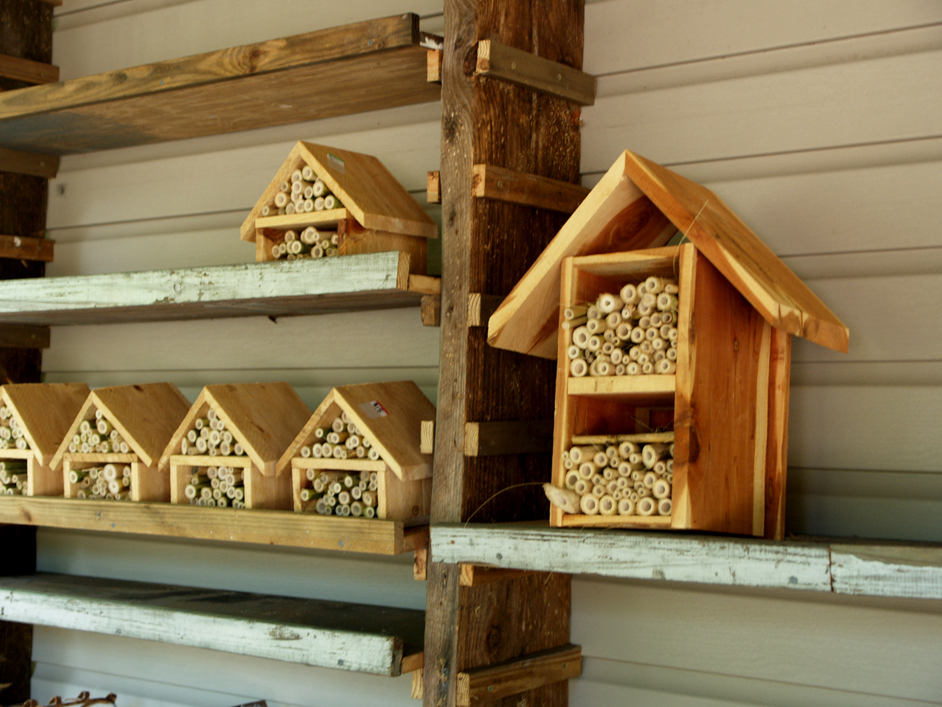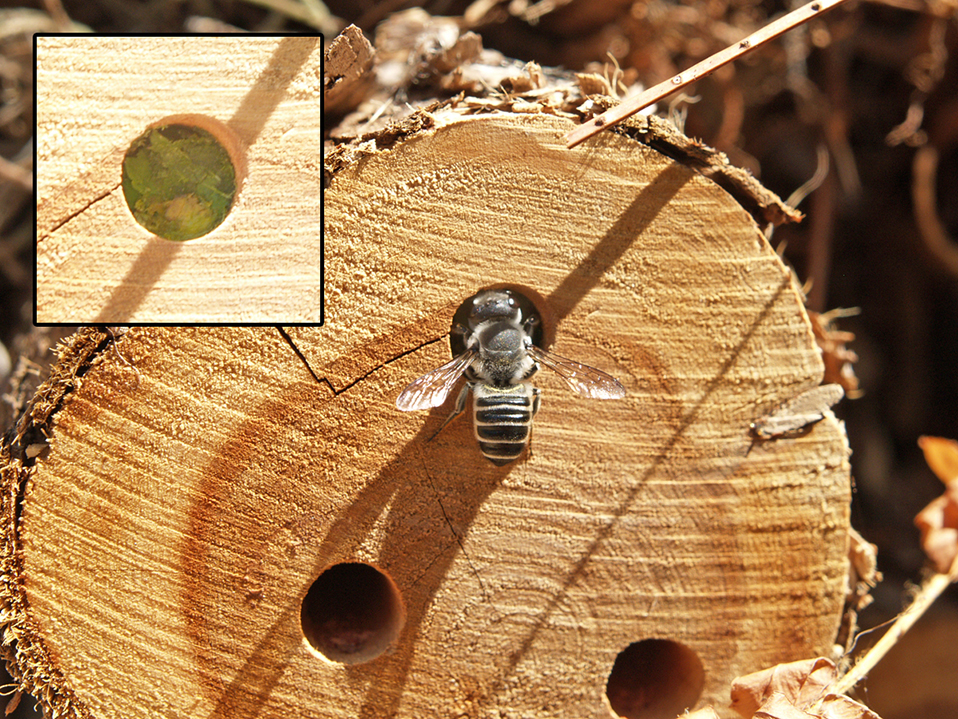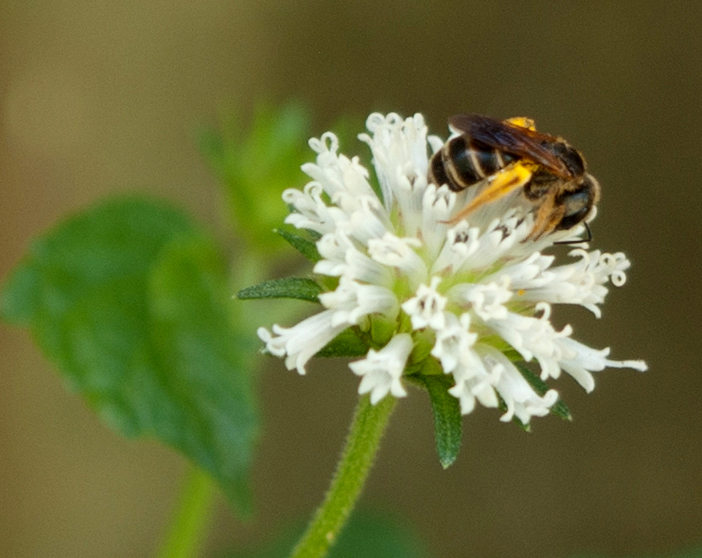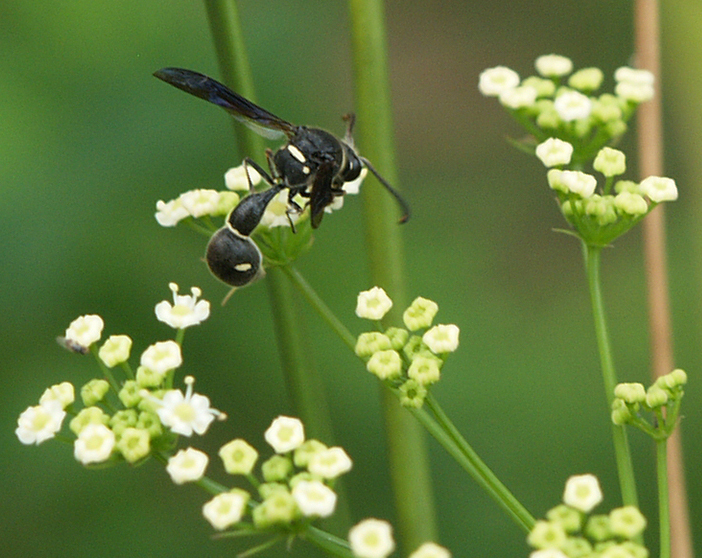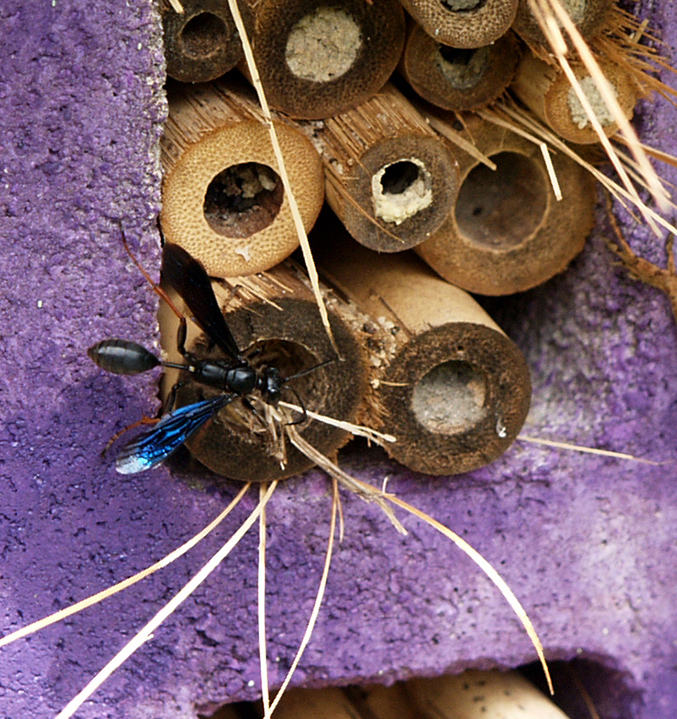Bringing the buzz back to your garden
Bee “tower” close-up by Taryn Evans
by Taryn Evans
It is well known that, in the last decade or so, honey bee populations worldwide have significantly diminished due to unknown causes. Less known, however, is the fact that native bee populations in North America are also in decline. The reason for this is less of a mystery — it is primarily the result of habitat loss. As more rural and wild landscapes become suburban and urban, there is less space and materials needed by native bees for laying eggs and feeding their young. Since bees are the preeminent pollinators of both cultivated and wild plants, the effects of fewer bees on crop production and native plant communities are serious. But there is a way for you to help. Create a space in your garden that is attractive to native bees and encourage them to stay.
Most native bees are solitary — that is, they live alone, occupying a nest either in the ground or in above ground tunnel-like cavities in natural or man-made materials. This is in contrast to the social, hive-dwelling bees such as honey and bumble bees that most people are familiar with and often fear. Honey and bumble bees are aggressive and sting because they are defending their colony and a queen. Solitary bees, on the other hand, are peace-loving creatures who are too busy laying eggs, gathering pollen to feed their future young, and making a proper nest for their eggs to be bothered with a bipedal giant who might be hanging around the area. In Florida, there are over 300 species of native bees, many of which are easy to entice to your garden with the right plants and a nest site that you make just for them.
Now that you know you are not really inviting a bunch of tiny terrorists to your garden by making a bee-friendly space, what’s next? Well… food, of course! And for bees, that means flowers — and lots of them! You’ll want to plant as many as you can make room for in the space you have, but more importantly, you’ll want to plant native wildflowers as these are the plants alongside which our native bees have evolved. Experts say that bees also have a preference for flowers that are yellow, blue, violet or white. Plant the flowers in clumps and make sure there is variety in both plant size and flower shape and size. Solitary bees can range in size so you need to provide flowers that can be readily used by all types of bees. Some of the best wildflowers for bees here in Florida include sunflowers, partridge pea, dotted horsemint, blanketflower and ironweed.
Once you have established your beautiful wildflower garden, you’ll now need to provide accommodations for a growing family — and by family, I mean many female bees and lots of eggs. If you have trees and shrubs in your landscape and are rather easygoing when it comes to gardening chores like pruning and hauling away dead stems, or if your soil is not covered completely with sod, other vegetation or mulch, you may already be providing nesting space to some native solitary bees. But if you are like many here in Florida who live in cities, subdivisions or retirement communities, you probably keep too tidy a garden for bees to find much that is useful for nesting. In this case, you will need to buy or construct an artificial nest box.
The easiest bees to create housing for are the tunnel-dwelling species, which includes mason and leafcutter bees. In nature, these bees typically make their homes in the hollow stems of certain plants or in tunnels drilled in dead wood by beetles. The simplest home to construct for these bees is a log, large branch or untreated block of wood in which you drill holes ranging in size from 3/32” to 3/8” in diameter. The depth of the hole needed will vary from 3” to 6”; the smaller the diameter of the hole, the shorter the depth of hole required. Be sure to not drill all the way through the wood as bees prefer to have a closed end to their nesting tunnel. Use a sharp bit to drill clean holes as bees may avoid tunnels with rough walls.
Another approach to a nesting box involves durable, hollow plant stems that are cut to form a tube. The most commonly used plant here in Florida for this is bamboo. When you cut the stems, be sure that you cut below a node to ensure that the tube will have a naturally closed end. Gather several stems and either strap them together to form a bundle or pack them tightly into a container such as a tin can or plastic bucket, with the open ends of the stems facing out. My husband and I make the nesting boxes we sell out of cypress fence slats and bamboo, but if you have the tools and materials, you can build a simple attractive box yourself. Be sure to use material that doesn’t require paint or stain.
If you have the space, however, and are a bit more ambitious, the best design for a solitary bee nest box is one that is incorporated into a larger shelter that can also be used by a variety of insects and other small critters. This type of structure is most commonly known as a “bug hotel.” Your drilled blocks of wood or bundles of stems will form only part of a structure that may also use twigs and small branches, bark pieces, pine cones, bricks and other natural (or possibly man-made) materials to attractively house ladybugs, green lacewings, assassin bugs, anoles, tree frogs and more; all of these are useful and beneficial creatures for the gardener who may prefer to rely more on integrated pest management strategies, or one who welcomes those creatures that help form the foundation for a healthy backyard habitat. If you type “bug hotel” into any online search engine, you’ll find more than enough photos to inspire some imaginative ideas for your own backyard creation.
Speaking of integrated pest management, any bee nesting box you place in your garden will also attract a number of solitary wasp species. These wasps are similar to solitary bees, but they are only minor pollinators compared with bees. Their most important function in the garden is as a hunter of pest insects like many caterpillars of moth species that do damage in our veggie gardens or pantry closets.
Once you have made your nest box, you’ll want to consider these simple guidelines to help identify a good site to locate it. First, place it as near as possible to the plants and flowers the bees will be foraging from. Many native bees are very small and their flight range is consequently quite limited. The closer the female bees are to their food, the more time they have for foraging. If you have a veggie garden, you can place a box nearby, but be sure to have a variety of other blooming flowers near the vegetable plants. Place the box facing east, if possible, which will allow bees to warm their bodies soon after the sun rises and get them out and active sooner. As well, try to place the box out of the late day heat. It’s best to have the box raised off the ground so that it does not sit on damp earth or get covered by vegetation, but any height will work. Be aware that ants might discover your box at some point if it is accessible to them; you may need to watch for this and make plans to discourage them. You might even need to move the box, but try not to move it very far so the bees can find their nests. Other good locations could be the side of a shed or hanging from a tree limb. If you choose to hang it, be sure it’s sheltered from strong winds.
So you’ve built it and they have come. Now what? Some maintenance of your next box will be required to keep healthy populations of bees for the long term in your garden. Nest boxes should be cleaned once a year. Tubes should be replaced every year or two. This will help prevent fungus growth and infestations of undesirable insects such as mites.
In welcoming native bees to your garden, I hope you will also discover the pleasure that comes from watching both bees and solitary wasps using their nest box and from knowing that you were able to recover a small bit of their lost habitat. Even if it is only a mimic of the natural it replaces, it is one piece in a hopefully enlarging mosaic of interconnected backyard habitats.
Taryn and Terry Evans own Creative Garden Structures, a small business that sells bee, bird and bat boxes; custom garden structures; and native plants. For more information, visit visit www.creativegardenstructures.com or www.facebook.com/creativegardenstructures.
Further reading:
- Attracting Native Pollinators, The Xerces Society Guide, 2011: a great comprehensive resource, everything you need to know about native bees in one place.
- Insects and Gardens: In Pursuit of a Garden Ecology, Eric Grissell, Timber Press, 2001: an inspiring, amusing and easy to read book that will have you rethinking how you feel about insects if you think you don’t like most of them.
- The Xerces Society for Invertebrate Conservation, www.xerces.org: lots of information and also many useful downloadable and printable fact sheets.
- The Metropolitan Field Guide, www.metrofieldguide.com: a blog and more with useful links, ideas for built habitats and much more; type in “bug hotels” in the search engine and check out the eye-popping designs.

